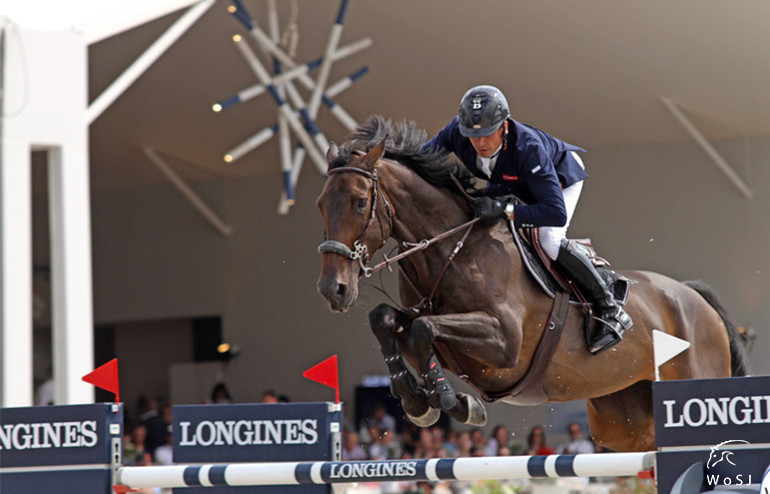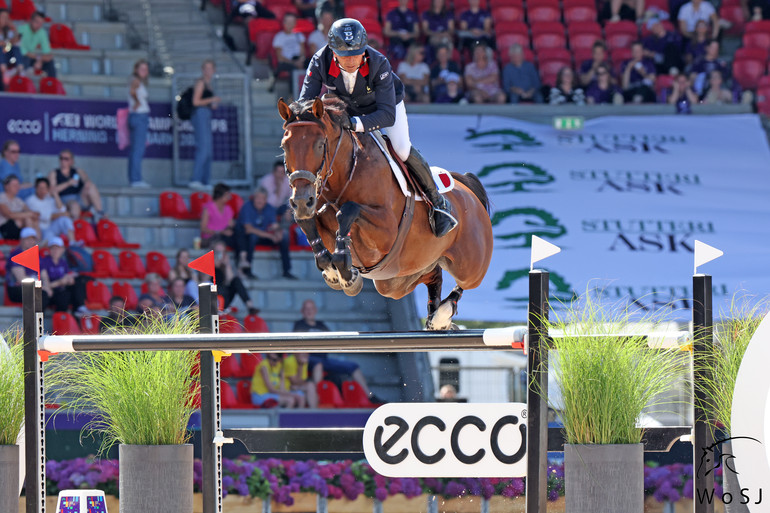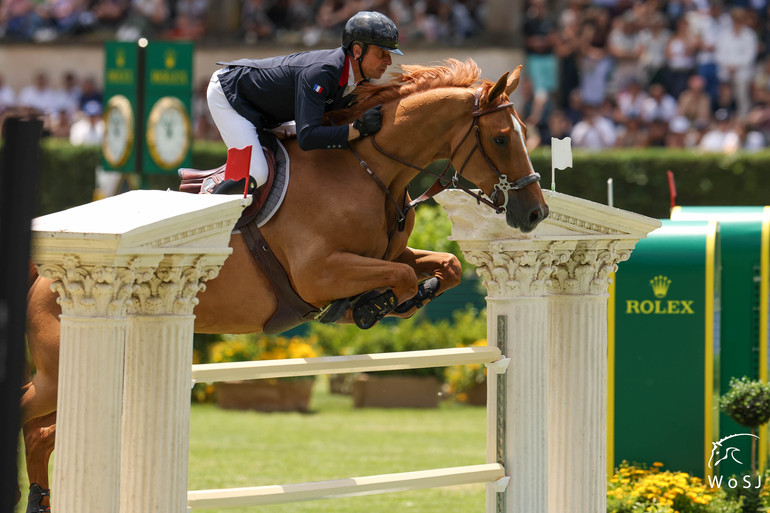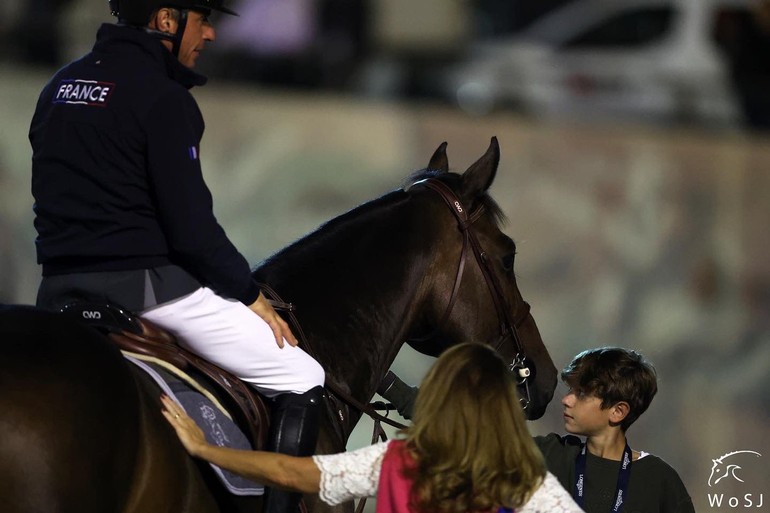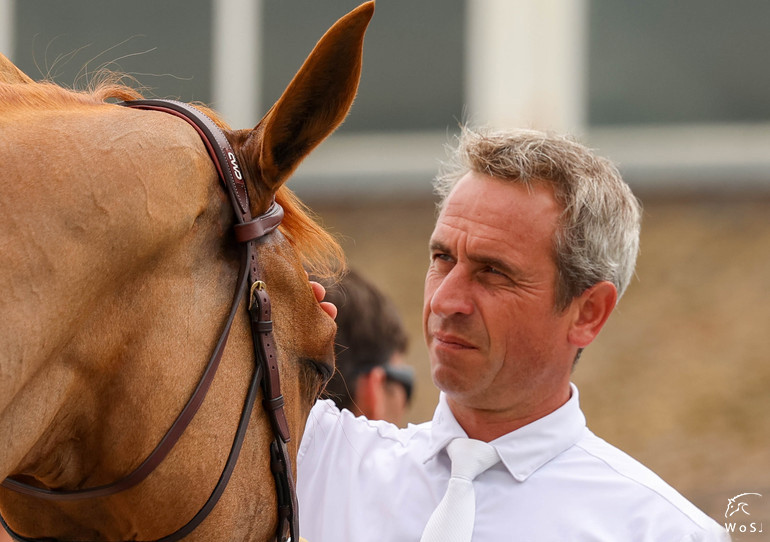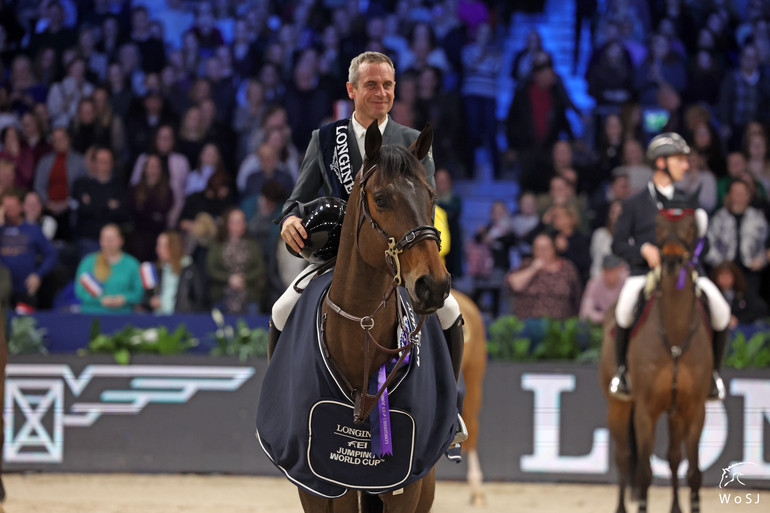Text © World of Showjumping
When World of Showjumping in 2017 sat down with Julien Epaillard, the French rider – already back then known as one of the fastest on the circuit – was ranked just within the top 40 on the Longines Ranking, had never done a senior championship, let alone been a mainstay on the French Nations Cup teams. Fast-forward six years, and the 47-year-old is sitting second on the world ranking – and is fully focused on the 2024 Olympic Games on home soil. “I have been lucky to have good horses and people around me who believe in me,” Epaillard says. “I try to go the way my horses take me – I am not focused on anything else than them. All I have done, is do what my horses are capable of.”
The right horsepower
Countless speedy victories with horses like Cristallo A LM (Casall x Corofino 2), Usual Suspect d’Auge (Jarnac x Papillon Rouge) and Safari d’Auge (Diamant de Semilly x Papillon Rouge) had earned Epaillard the nickname “The Flying Frenchman” when he in 2018 met the Sadran-family. Through them, Epaillard got the ride on Queeletta (Quality 9 x Landor S) and Virtuose Champeix (Rubins Des Bruyeres x Avec Espoir) and from there on he has had the right horsepower.
I try to go the way my horses take me – I am not focused on anything else than them
“Olivier Sadran wanted to have a team in the Global Champions League, and he asked if I wanted to join them,” Epaillard recalls. “He was willing to buy a few horses for me to ride, and we found Queeletta and Virtuose Champeix. For me, joining Sadran’s team in the GCL was a good opportunity. It is tough to compete on the highest level, but in Queeletta and Virtuose I had two good horses and we started to have good results with them. I trained Olivier’s daughter Jeanne as well, which was a new experience for me. I think it was a good time for all of us.”
You can only jump the shows your horses can jump
Alongside the Sadran-family, Michel Hecart has played an important role in Epaillard’s success. From Hecart, Epaillard got horses such as Toupie de La Roque (Kannan x Nabab de Reve) and Caracole de La Roque (Zandor Z x Kannan) – the latter his partner at the World Championships in Herning last year.
I have never been focused on the ranking at all
“For me Michel is a real horseman, and I speak a lot with him, about the programs of my horses, how we manage them daily… He has also sent me horses during the years, like Alibi de La Roque (Mylord Carthago x Kannan), Toupie de La Roque and most recently Caracole de La Roque. The combination of having good horses and being able to get into the bigger shows has then resulted in a higher ranking. However, I have never been focused on the ranking at all. I listen to my horses and when I feel they are in good form, that they are ready, then I go to a show. If they don’t feel right, I don’t go and I give them a break,” Epaillard says.
“Before, I did not do so many Nations Cups, and people thought I did not want to ride on the team,” Epaillard continues. “However, it was never about me not wanting to ride for my nation, it was about not having the right horses for those shows. I am open to ride for my country, and it is my priority when I have the right horsepower. You can only jump the shows your horses can jump! As an example, Usual was a top horse, but he did not like the open water, and he was not the most consistent, so we would not have been useful for the French team. You need a consistent horse to be a part of the national team, and when I think I have one, and people believe in me, I go.”
I listen to my horses and when I feel they are in good form, that they are ready, then I go to a show
Epaillard has found great support in Henk Nooren, the French Chef d’Equipe and trainer. “Henk does not want to change me totally, or tell me what to do,” Epaillard tells about their relationship. “He gives me ideas and little suggestions, minor things that add up to the bigger picture and are very important. Henk has tried to help me find the right horses. I know he believes in me, so I try to organize my stable the best I can. Henk knows horses and top sport, and for us in France it is a great advantage having him. The atmosphere in the French team is good at the moment; I think we are all focused on Paris and try to help each other. It is not a sport where you should fight with the other riders, it is better to help each other; we can learn from everyone. However, we do need good horses. We do what we can, but it is not easy; everyone is looking for the same, so it is complicated to find the right horses for the top sport.”
Caracole de La Roque
Last year, Caracole de La Roque was the name on everyone’s lips. After securing the win for the French team in the CSIO5* Nations Cup in Knokke and winning both the CSI5* Grand Prix and the CSI5* World Cup in Lyon, as well as the CSI5* World Cup in Madrid, the fairy-tale partnership between Epaillard and the charming mare came to an end after the IJRC Rolex Top 10 Final in Geneva. The rumour mill was spinning around Caracole’s sale for weeks before it was even finalized, but eventually the deal was closed and the talented mare flew over to the United States in January to start a new career with Karl Cook. “Caracole is maybe the best horse I rode in my life,” Epaillard says. “One of the best, for sure. The idea was clear from the start with her owner Michel Hecart: Caracole was always for sale. However, we wanted to do it at the right moment, with the right people. I never had pressure from Michel, and Caracole’s development was incredible. She is a special mare; she has so much blood, so much quality, so much scope. I was very proud to ride her. It was important for us that she would get a good home, with somebody we thought could ride and not with an amateur. I am happy that Karl bought her, and I think they have already made some good results. She is not an easy mare; you need time to get to know her.”
Caracole is maybe the best horse I rode in my life
With Caracole, Epaillard did his first major championship as part of the French team at the 2022 World Championship in Herning, Denmark. “My first championship in Herning was a good experience. I think it was important for me thinking towards Paris,” he tells. “The pressure at these kinds of championships is special, and you cannot understand it until you are there. You stay with the team, everyone is really focused, the days are long with only one horse. You have to be focused and centred only for that one minute, and the rest of the day you need to try and stay relaxed. It is a different pressure, but a positive kind. Herning was good for me, a new experience and a step further from riding a normal Nations Cup show. I did not jump the individual final with Caracole, because she did well for the team, and as I had no chance for medals individually, we wanted to save her. I think it is important that my horses come home with a good experience. I believe Caracole learned a lot in Herning and so did I. After Herning she got a break and then she won so much indoors. I have a good feeling about my time with her; I believe we did a good job. She is really a special mare, with a big character.”
Dubai du Cedre
With the 10-year-old mare Dubai du Cedre (Baloubet du Rouet x Diamant de Semilly), Epaillard now aims for the 2023 European Championship in Milan. “She won the French championship as a 7-year-old, and she is a mare I have known for a long time. I always liked her and when her owners had the idea that she should do bigger shows, they asked if I would ride her. I started with her last year, one show before Geneva, and in Geneva I directly had a good feeling. We decided to create an investment fund to be able to keep her with Paris in mind, because her owner is a breeder who would have wanted to sell her at some point. With a few people, some with equestrian background and some without, we bought 70%. We will see how the story evolves but at the moment we are very happy with her.”
I think it is important that my horses come home with a good experience
“She was good in La Baule, but she is only ten,” Epaillard continues. “I will see how she feels, but for now the plan is to take her to Milan. Maybe I end up feeling that she is not ready, and if I have any doubts, I will not go. I don’t want to go to a show because I have to go, I want to go when my horses are ready. And with ready, I mean either ready to win or at least ready to learn. If she feels fresh and good, I might go to just get her the experience. She might not be competitive on that level yet, but if she feels ready to jump those courses with confidence, I can go – like I did with Donatello in the World Cup Finals. I was thinking that we would finish between the ten best in Omaha, so in the end I was a bit disappointed, but I do think Donatello learned something there. That is the idea with Dubai for Milan as well; I think we can be a good member for the team and contribute there, but I don’t think we will have a chance for an individual medal, because she is so young and not experienced enough.”
Donatello d’Auge
With his home-bred 10-year-old Donatello d’Auge (Jarnac x Hello Pierville), Epaillard has this year won the CSI5* 1.60m LGCT Grand Prix of Monte Carlo, the CSI5* LGCT Grand Prix of St. Tropez, the CSI4* Grand Prix of Bourg-en-Bresse, the CSI5* 1.60m World Cup in Amsterdam and placed second in the CSI5* 1.60m Rolex Grand Prix in s’Hertogenbosch. “He is easy, really easy,” Epaillard says about his superstar. “In his case we actually started a bit earlier than we usually do with our young horses; when he was five. My riders rode him between the age of five and eight, up until two-star Grand Prix level. When he was eight, he finished third in a CSI2* Grand Prix in St. Lo in October and then he had a break over the winter. Then my wife Susana started with him in January in Oliva, in small classes, to make him fit again after a long break. I started to ride him in the beginning of March last year. He jumped his first 4* Grand Prix in A Coruna and his first 5* Grand Prix in Rome last year and won his first 5* Grand Prix as a 10-year-old in Amsterdam. We took our time with him. It is never easy to tell from a 5- or 6-year-old horse how they are going to end up; if you have a superstar or not. Donatello always jumped good, he was super in his head, always very careful and scopey, but it is not easy to know what you have before you actually do it with them. Winning the Grand Prix in Monaco with Donatello was special, because I was really focused on that, and so was the first Grand Prix win with him as well.”
In our sport, it is important that the horses do it with pleasure
With Dubai and Donatello, Epaillard has two possibilities for the 2024 Paris Olympic Games. “We try to do our best,” he says. “I am very focused on Paris with Donatello, but also with Dubai. It is better to have two horses, so I try to do my best to have them ready for Paris – for us it is very important. I am now 47, and I never did Olympic Games before… What makes it even more special is the fact that we will be competing in Paris, so I try to make the best possible plan. My horses will be young, they will both be eleven, so I try to give them the best experience while also keeping them fresh. Donatello for example won a lot this year, and after A Coruna I decided to give him a break, he has jumped enough. I don’t know when I will start again with him – I might give him a break until the indoor shows start. In our sport, it is important that the horses do it with pleasure. If you want to stay long time on the highest level with the same horse, you have to make sure your horse is happy to go to the show.”
Breeding quality
Currently, Donatello d’Auge leads the WBFSH Breeder Ranking. The system the Epaillards’ have in place, was created by Julien’s wife Susana. “Susana started breeding with some mares she used to ride, and we also bought a few mares only for breeding,” he explains. “At the moment we have around 15 mares and we don’t do so much; we have between six and nine foals per year. We don’t want to make this a big thing; we want to stay small and focus on quality. We don’t do embryo transfer or ICSI, our mares carry themselves and each only has a few foals – that is why we have 15 mares, because after one foal, they always get a year or two of a break. The only time we might do embryo transfer is on the older mares when we don’t want to take any risks with their health.”
We want to stay small and focus on quality
“Our young horses only start jumping when they are six, until then they stay in the field,” Epaillard continues to tell about the system he has in place to produce the young horses. “They get ridden a little between five and six, but we just do three months of flat work and then they return to the field. When they are six, we can jump small with them, and in July, or August, we see which ones are good – some we sell, some we keep. My objective is to breed top horses for five-star level, or minimum 1.50m horses. When they are six, they are normally finished with growing and by then you will know much more about them. I think it is not easy to know if a horse will be good or not only after seeing them lose jump as a three-year-old, so we do like this. After six months of work as a 6-year-old, they can jump a little course and then we already get much more information. Also, they have more value when they are six than when they are three. However, I am fully aware that not everyone can do this from an economic point of view and have to value their horses earlier. The first six years you basically just have to wait, but then you will have a new generation every year. Until they are eight, my horses never jump more than 1.45m. This is my system, and maybe I will change it one day; I never believe that my system is the best, I always try to learn and develop and learn from my mistakes. I question myself all the time; what can I do better for my horses?”
We don’t do embryo transfer or ICSI, our mares carry themselves
“It is always special when you have bred the horse and then win a five-star show, like Paris with Usual,” Epaillard – who has enjoyed many successful moments with their home-bred horses – says. “That was something really emotional for us; Usual had a unique character and it was something incredible that he gave us that day. That is why we do this; to live these special moments with our horses.”
Keeping it simple
Having his horses barefoot, riding many of them in a hackamore, Epaillard’s system is very simple – also at home. “During the summer, my horses sleep outside; the mares are together and the geldings are together,” he tells. “In the morning they come back to their boxes and then they go for a walk. In the winter we do the reverse; we ride the horses in the morning and they are out for the rest of the day because the nights are too cold for sport horses. It is very simple, nothing special – maybe you could say it is a bit old school. We give them 12kg of hay every 24h and then adapt the food around that as needed.”
During the summer, my horses sleep outside
“In my training system, I jump a lot, but small, minimum two-three times a week with a horse that has no show,” he continues. “I do 19 jumps, take a three-minute break and then do again 19 jumps – like a small course, very small. I think it is good for their bodies to work like this. I focus on little details; not cut the turns, have the horses waiting, do exactly the strides I want to do. I approach it like flat work, but with small fences."
I believe riding is all about feeling
"I am not the best in flat work… I simply try to feel my horses; if he is fresh, I canter more, if he feels tired, I walk," Epaillard continues. "I believe riding is all about feeling. For me it is important to feel that the horses move well, that they are flexible, that I have a good connection with them, that they are in good balance, and as relaxed as possible. There is a way for every horse, but not one way that fits every horse. I want to find the best solution for each individual and there is never only one way, but many ways. For me the connection I have with my horse is very important, but in the end, I have to control the way they jump, the trajectory over the fence. When I am in the warm-up, I try to find the best trajectory. I always make a plan A, but many times I have to go for plan B – and sometimes I win, sometimes I lose.”
Fairness has the best return
Despite the many recent successes and sitting second on the world ranking, the only thing that matters for Epaillard is his horses and the connection he has with them. “I have had many special connections with many horses during my career – they are all special,” he says. “I really like Donatello, and he is very quiet, very calm, he likes to cuddle, and Dubai is the opposite, like a warrior, she has a lot of blood, but I enjoy my time with her as well. I think that all top horses have special characters, they are usually all big personalities, and when you know them a little bit, you always find something to love about them. And after you live some good results with them, that makes the relationship even more special. However, the relationship evolves month after month and year after year; we get to know them a bit more every day, they get to know us better.”
I live from my passion, I am every day with my horses
“If tomorrow I only have two-star horses, I will still be happy – then I will do two-star shows,” Epaillard concludes. “If I am rank 30 tomorrow, I will not die. I am not thinking about the points at the beginning of the month; I do my plan based on the feeling my horses give me. I prefer five-star shows for sure, but I live from my passion, I am every day with my horses… That alone is still enough, as it has always been. I like this sport and I like the shows, but I will only do five-star shows when I have the horses for it – it is that simple. My main goal is to be as fair as possible with my horses; they give back when we are fair with them, that is what I believe.”
14.8.2023 No reproduction of any of the content in this article will be accepted without a written permission, all rights reserved © World of Showjumping.com. If copyright violations occur, a penalty fee will apply.




